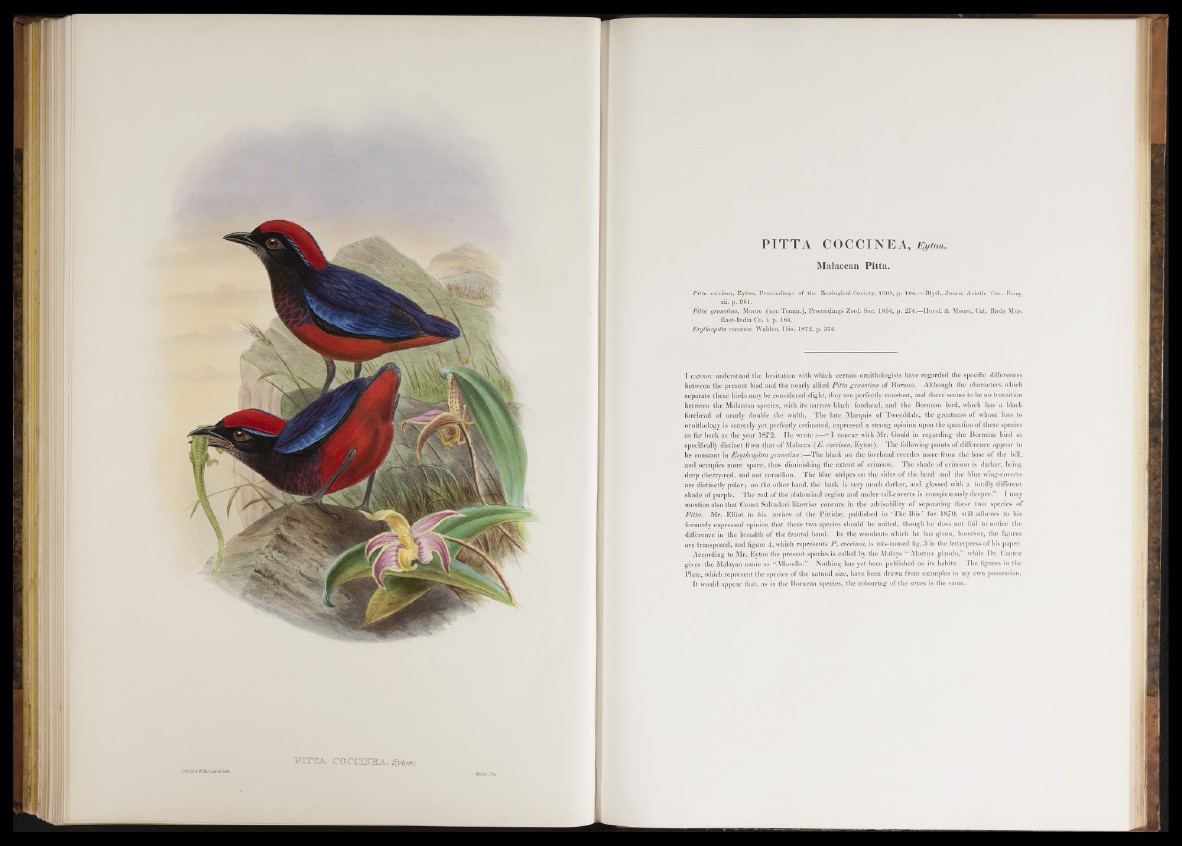
PITTA COCCINEA, %*>».
Malaccan Pitta .
Pitta coccinea, Eyton, Proceedings of the Zoological Society, 1839, p. 104.—Blyth, Journ. Asiatic Soc. Beng.
xii. p. 961.
Pitta granatina, Moore (nec Temm.), Proceedings Zool. Soc. 1854, p. 274.—Horsf. & Moore, Cat. Birds Mus.
E ast-India Co. i. p. 184.
Ergthropitta coccinea, Walden, Ibis, 1872, p. 374.
I c a n n o t understand the hesitation with which certain ornithologists have regarded the specific differences
between the present bird and the nearly allied Pitta granatina of Borneo. Although the characters which
separate these birds may be considered slight, they are perfectly constant, and there seems to be no transition
between the Malaccan species, with its narrow black forehead, and the Bornean bird, which has a black
forehead of nearly double the width. The late Marquis of Tweeddale, the greatness of whose loss to
ornithology is scarcely yet perfectly estimated, expressed a strong opinion upon the question o f these species
as far back as the year 1872. He wrote :—“ I concur with Mr. Gould in regarding the Bornean bird as
specifically distinct from that o f Malacca (E . coccinea, Eyton). The following points of difference appear to
be constant in Ergthropitta granatina:— The black on the forehead recedes more from the base of the bill,
and occupies more space, thus diminishing the extent of crimson. The shade of crimson is darker, being
deep cherry-red, and not vermilion. The blue stripes on the sides of the head and the blue wing-coverts
are distinctly p a le r; on the other hand, the back is very much darker, and glossed with a totally different
shade of purple. The red of the abdominal region and under tail-coverts is conspicuously deeper.” I may
mention also that Count Salvadori likewise concurs in the advisability of separating these two species of
Pitta. Mr. Elliot in his review of the Pittidee, published i n ‘The Ib is ’ for 1870, still adheres to his
formerly expressed opinion that these two species should be united, though he does not fail to notice the
difference in the breadth of the frontal band. In the woodcuts which he has given, however, the figures
are transposed, and figure 4, which represents P . coccinea, is mis-named fig. 3 in the letterpress o f his paper.
According to Mr. Eyton the present species is called by the Malays “ Mortua plando,” while Dr. Cantor
gives the Malayan name as “Allo-allo.” Nothing has yet been published on its habits. The figures in the
Plate, which represent the species of the natural size, have been drawn from examples in my own possession.
It would appear that, as in the Bornean species, the colouring of the sexes is the same.